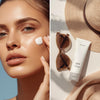
Sun protection 365 days – SPF is not a summer product
4 min reading time

4 min reading time
Sunscreen isn't a summer product. Learn from PRO HAAR experts why daily SPF is the secret to healthy, youthful skin – 365 days a year.
Sun protection 365 days a year – SPF is not a summer product
The sun gives life, energy, and a healthy complexion—but its rays are also the biggest cause of skin aging, pigmentation, and cell damage. Yet, most people only use sunscreen in the summer or on vacation.
The truth? UV damage is present year-round. The experts at Diana Beauty & PRO HAAR explain why SPF is a daily must, how to use it correctly, and which mistakes to avoid.
Why UV protection is necessary every day
Sunlight consists of different types of radiation:
• UVA rays – penetrate deep into the skin and cause aging, wrinkles and loss of elasticity.
• UVB rays – cause sunburn and DNA damage.
Even on cloudy or winter days, UVA rays penetrate clouds and windows. They are present year-round and account for 95% of UV exposure. That's why daily SPF isn't a luxury, but a necessity.
What happens without SPF?
✔ Faster breakdown of collagen and elastin → sagging skin.
✔ Formation of pigment spots and uneven skin tone.
✔ Accelerated aging (photo-aging).
✔ Increased redness, inflammation and rosacea.
✔ Risk of DNA damage and skin cancer.
Understanding SPF – What Do the Numbers Mean?
The SPF value (Sun Protection Factor) indicates how long your skin is protected against UVB rays .
For example, if you normally burn after 10 minutes, SPF 30 theoretically offers protection for 30× that time (≈300 minutes).
But more important than the number is the correct application and quantity.
How do you use SPF correctly?
✔ Apply a generous amount every morning – approximately 2 fingerfuls for face and neck.
✔ Apply as the last step of your skincare (after cream, before makeup).
✔ Repeat every 2-3 hours when exposed to sun or screen light.
✔ Don't forget your neck, ears, hands and décolleté.
✔ Remove thoroughly in the evening with double cleansing.
Chemical vs. mineral filters
• Chemical SPFs (such as avobenzone, octocrylene) absorb UV rays and convert them into heat.
Advantage: light texture, ideal under make-up.
• Mineral SPFs (such as zinc oxide, titanium dioxide) reflect UV light.
Benefit: soothing for sensitive skin, immediate protection.
Combination formulas often offer the best balance between comfort, protection and skin tolerance.
SPF and skin care – the perfect combination
Always use SPF together with antioxidants and moisturizing ingredients:
✔ Vitamin C + SPF → strengthens protection against free radicals.
✔ Niacinamide + SPF → soothes and prevents pigment spots.
✔ Hyaluronic acid + SPF → keeps the skin supple and prevents dehydration.
Common mistakes with sun protection
❌ Only use SPF in summer.
❌ Applying too little product.
❌ No recurrence with prolonged exposure.
❌ Thinking that makeup with SPF is enough.
❌ No protection in cloudy conditions or in a car.
Extra protection all year round
✔ Winter: UV rays reflect off snow – still use SPF 30.
✔ Spring & summer: choose broad spectrum SPF 50.
✔ Autumn: Combine SPF with moisturising cream to protect against the cold and wind.
✔ Internal use: Use a light SPF product as UVA penetrates glass and screen light.
Pro tip: Use a broad-spectrum SPF (UVA + UVB + HEV) with antioxidants. Choose a texture based on your skin type – gel for oily, cream for dry, fluid for normal or combination.
Conclusion – protection is the best anti-aging
SPF isn't a seasonal trend, but the foundation of every skincare routine. Daily protection not only maintains youthful skin but also prevents permanent damage.